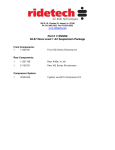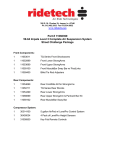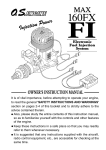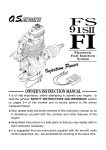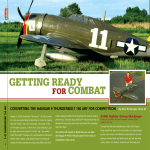Download Manufacturer Instructions for Ridetech Complete
Transcript
350 S. St. Charles St. Jasper, In. 47546 Ph. 812.482.2932 Fax 812.634.6632 www.ridetech.com Part # 12090109 64-66 Mustang Complete NA CoilOver Kit Front Components: 1 12093509 Non Adjustable Front CoilOvers 1 12099599 Front Tru-Turn Suspension Package Rear Components: 1 12096509 Non Adjustable Rear CoilOvers 1 12087199 Bolt-on 4 Link Components: 1 85000000 Spanner Wrench 350 S. St. Charles St. Jasper, In. 47546 Ph. 812.482.2932 Fax 812.634.6632 www.ridetech.com Part # 12093509 64-67 Mustang Front NA CoilOvers For Use w/ Strong Arms Shock Assembly: 2 24039999 2.6” Stroke Single adjustable shock 2 90001994 .625” I.D. bearing 4 90001995 Bearing snap ring 2 70008976 Short Delrin stud top – 2” Components: 2 59080650 Coil spring – 8” long / 650 # rate 2 90002312 2” stud top base 2 90002222 Spring retainer kit (included upper and lower spring retainer, screw & clip) 2 90001902 Aluminum cap for Delrin ball 2 90001903 Delrin ball upper half 2 90001904 Delrin ball lower half 2 90002356 Upper Shockwave mount 2 90000563 Aluminum Upper plate Hardware: 2 99562003 9/16” SAE Nylok jam nut Stud top hardware 6 99311012 5/16” x 1” USS Flange bolts Upper mount to strut tower 1. Impact Forged, Monotube shock 2. Rebound adjustment knob (SA Only) 3. Upper coil spring retainer 4. Lower coil spring retainer 5. High tensile coil spring 6. Set screw 1. Stud top base 2. Lower Delrin ball half 3. Upper Delrin ball half 4. Aluminum cap 5. 9/16” Nylok jam nut 6. Threaded stud 7. Adjustment knob (SA Only) 8. Screw 9. Snap ring 1. Place the upper plate on top of the strut tower. While holding the upper Shockwave mount up to the bottom of the strut tower, fasten the assembly with three 5/16” x 1” flange bolts. 2. Place the stud up through the upper mount. (See diagram) 3. Attach the bottom of the shock to the upper arm w/ the hardware supplied w/ the kit. Ride Height We have designed most cars to have a ride height of about 2” lower than factory. To achieve the best ride quality & handling, the shock absorber needs to be at 40-60% overall travel when the car is at ride height. This will ensure that the shock will not bottom out or top out over even the largest bumps. Measuring the shock can be difficult, especially on some front suspensions. Measuring overall wheel travel is just as effective and can be much easier. Most cars will have 4-6” of overall wheel travel. One easy way to determine where you are at in wheel travel is to take a measurement from the fender lip (center of the wheel) to the ground. Then lift the car by the frame until the wheel is just touching the ground, re-measure. This will indicate how far you are from full extension of the shock. A minimum of 1.5” of extension travel (at the wheel) is needed to ensure that the shock does not top out. If you are more than 3” from full extension of the shock then you are in danger of bottoming out the shock absorber. Adjusting Spring Height When assembling the CoilOver, screw the spring retainer tight up to the spring (0 preload). After entire weight of car is on the wheels, jounce the suspension and roll the car forward and backward to alleviate suspension bind. • If the car is too high w/ 0 preload then a smaller rate spring is required. Although threading the spring retainer down would lower the car, this could allow the spring to fall out of its seat when lifting the car by the frame. • If the car is too low w/ 0 preload, then preload can then be added by threading the spring retainer up to achieve ride height. On 2.6” - 4” stroke shocks, up to 1.5” of preload is acceptable. On 5-7” stroke shocks, up to 2.5” of preload is acceptable. If more preload is needed to achieve ride height a stiffer spring rate is required. Too much preload may lead to coil bind, causing ride quality to suffer. 350 S. St. Charles St. Jasper, In. 47546 Ph. 812.482.2932 Fax 812.634.6632 www.ridetech.com Part # 12099599 64-66 Mustang Tru-Turn Suspension Package Front Components: 1 12093699 Upper Strong Arms 1 12092899 Lower Strong Arms 1 12099500 Tru Turn System 350 S. St. Charles St. Jasper, In. 47546 Ph. 812.482.2932 Fax 812.634.6632 Part # 12093699 64-66 Mustang Upper StrongArms For Use w/ Shockwaves or CoilOvers Must be Used with Ridetech Tru-Turn Setup Components: 1 90002340 Driver Upper StrongArm 1 90002339 Pass Upper StronArm 2 70010866 Upper ball joint 2 70010865 Billet Aluminum drop cross shaft 4 90001589 Heim ends – ¾”-16 thread x 5/8” I.D. 2 90002341 Alignment shim 4 90002043 .500” I.D. Bearing spacer Hardware: 4 99621002 5/8”-18 x 1 ¾” Gr.8 bolt Rod end to cross shaft 6 99501003 ½”-13 x 2 ½” Gr.5 bolt Cross shaft to body/Shock to upper arm 4 99502006 ½”-13 nut Cross shaft to body 8 99503001 ½” SAE flat washer Cross shaft to body 4 99503002 ½” lock washer Cross shaft to body 2 99502001 ½”-13 Nylok nut Shockwave/CoilOver to upper arm 4 99752004 ¾”-16 jam nut Heim ends 1. Bolt the upper StrongArm to the body using ½” x 2 ½” bolts, flat washers and lock washers. A shim is supplied and may need to be installed between the body and the arms to achieve proper alignment. 2. The arms are preset at the factory so the alignment should be close, but the vehicle must be aligned before driving. Note: The upper arm mounting holes on many cars have been redrilled 1” lower. This is done to improve the handling. Our cross shaft has the drop built into it, make sure to use the factory mounting holes. 3. Bolt the upper arm to the spindle using the hardware and cotter pin supplied. 4. Attach the Shockwave to the upper StrongArm using a ½” x 2 ½” bolt and Nylok nut. 5. This control arm is designed to work with our MuscleBar sway bar. The end link will attach to the front mounting tab on the upper arm. Item # 1. 2. 3. 4. 5. 6. 7. 8. 9. 10. 11. 12. 13. 14. Description Control arm Heim ends – ¾”-16 thread x 5/8” I.D. Alignment shim 5/8”-18 x 1 ¾” Gr.8 bolt 5/8” lock washer ½” SAE flat washer 5/8” SAE flat washer ½”-13 x 2 ½” Gr.5 bolt Ball joint Cross shaft ¾”-16 Jam Nut ½” Lock Washer ½”-13 Nut ½”-13 Nylok Nut Qty. 1 2 1 2 2 4 2 3 1 1 2 2 2 2 350 S. St. Charles St. Jasper, In. 47546 Ph. 812.482.2932 Fax 812.634.6632 www.ridetech.com Part # 12092899 64-66 Mustang Lower StrongArms To Be Used With Ridetech TRU-TURN Components: 1 90002334 Driver side lower arm 1 90002335 Passengers side lower arm 2 90000898 Lower ball joint 2 90001589 Kevlar lined heim end 4 90002338 Rod End Spacers 2 90001045 Control arm pivot bearing 2 90002336 Bearing housing 2 90002337 Bearing retaining plate 2 90000733 Aluminum bearing spacer 2 90000732 Bearing stud (Set to 2- 7/8”) Hardware: 2 99501024 ½”-13 x 3 ¼” Gr.5 bolt Lower arm to frame 2 99502001 ½”-13 Nylok nut Lower arm to frame 6 99311003 5/16”-18 x 1 ½ Hex Bearing housing 6 99313003 5/16” lock washer Bearing housing 4 99752004 ¾”-16 Jam nut Stud to arm 2 99752001 ¾”-16 Lock nut Stud to bearing 2 99753002 ¾” x 2” flat washer Stud to bearing Installation Instructions 1. Raise and support vehicle at a safe, comfortable working height. Let the front suspension hang freely. 2. Remove the coil spring, shock absorber, upper shock bracket, strut rod, sway bar, upper and lower control arms. Refer to factory service manual for proper disassembly procedure. 3. Be sure to remove the outer bushing sleeve from the strut rod frame mount. 4. Remove any excess undercoating or rust. 5. Using the bushing retainer as a template, mark the holes to drill with a center punch. 6. Remove the retainer and drill the holes with a 3/8” bit. 7. Place the bearing inside the bearing housing, then clamp it to the frame with the bearing retainer and the 5/16” x 1 ½” SHCS and lock washers. Front 8. The bearing stud should already be threaded into the lower arm, factory set at 2-7/8” (measuring from the end of the arm to the bearing). 9. Slide the stud through the bearing, then slide the aluminum spacer over the stud with the larger end toward the front of the car. Secure the assembly with a ¾” Nylok Nut and flat washer. Note: The caster setting should set at around 4.0 degrees positive. Vehicle must be aligned before driving. 10. Install the 2 aluminum spacers into the rod end that goes into the factory control arm pivot. 11. Attach the other end of the lower control arm to the factory frame mount using a ½” x 3 ¼” bolt and Hex nut. 12. Slide the ball joint boot over the ball joint, then place the spindle over the ball joint stud. A ball joint spacer will be necessary to align the castle nut with the cotter pin hole. Grease ball joint Note: Before installing the spindle, turn the ball joint stud so that the cotter pin hole faces front to back. This will make it easier to install/remove the cotter pin. Item # 1. 2. 3. 4. 5. 6. 7. 8. 9. 10. 11. 12. 13. 14. 15. 16. Description Driver side arm Kevlar lined Heim End Control Arm pivot bearing Bearing retaining plate Bearing stud (Set to 2- 7/8”) Ball Joint Heim end spacer Bearing Housing 5/16” Lock washer 5/16”-1 ½” Gr5 bolt Aluminum bearing spacer ¾”-16 Lock nut ½”-13 x 3 ¼’ Gr.5 bolt ½”-13 Nylok nut ¾” -16 Jam Nut ¾” X 2” Flat washer Qty. 1 1 1 1 1 1 2 1 3 3 1 1 1 1 1 1 350 S. St. Charles St. Jasper, In. 47546 Ph. 812.482.2932 Fax 812.634.6632 www.ridetech.com Part # 12099500 64 – 66 Mustang TruTurn System Item # Part # 1. 90002344 Description-Torque Specification Drag link bracket 2. 90001582 LH Thread Heim End 2 3. 99800003 5/8”-18 LH jam nut 2 4. 99800002 5/8”-18 RH jam nut 2 5. 90001590 Heim end 2 6. 90009931 Large stud – tie rod 2 7. 90002351 Inner tie rod stud 2 8. 90002345 Drag link stud 2 9. 90002346 Tie rod adjuster 2 10. 90002347 Driver steering arm 1 10. 90002348 Pass steering arm 1 11. 11009300 RideTech spindle 1 pr. 12. 99502010 ½”-20 Lock nut-50 ft lbs 2 13. 99432005 7/16”-20 castle nut-35 ft lbs 4 14. 99952002 3/32” Cotter pin 4 15. 99622005 5/8”-18 Thin top lock nut 2 16. 90002349 Driver steering stop 1 16. 90002350 Pass steering stop 1 17. 99502001 ½”-13 Nylok Nut 2 18. 99501019 ½”-13 x 1 ¼” Hex Head Bolt 2 19. 99622007 5/8”-18 Mechanical lock nut 4 99433002 7/16” Flatwasher 6 Qty. 1 350 S. St. Charles Street Jasper, In. 47546 www.ridetech.com THIS SYSTEM WILL ONLY WORK WITH RIDETECH STRONG ARMS Installation instructions This kit can be used with the OEM draglink or Borgeson Power Steering Conversion Kit 1. You should be using Ridetech Strong Arms and already have installed them. 2. Assemble the new RideTech draglink adapter bracket onto the OEM draglink with the supplied tapered studs and washers per the enclosed drawings. 3. Install the new RideTech spindles onto the control arms per the enclosed drawings. Ball joint nut torque = 83 ft lbs 4. Install the Steering arm and Steering Stop at the same time. The nuts should be on the frame side of the spindle. 5. Install the remainder of the Tru Turn steering linkage as shown in the attached drawings. MAKE SURE that ALL cotter pins are used in the appropriate places and that there is no binding or interference throughout the entire suspension travel. 6. Adjust the camber and toe roughly until you can get the vehicle to a proper alignment shop. The recommended alignment settings are: Camber - -.5 to -1.5 [within .3 from side to side] Caster – 4 to 7 degrees positive [run .5 degrees more on pass side to allow for road crown] Toe - 1/8 to ¼ toe in Feel free to experiment with alternative alignment settings that may be more appropriate for your particular driving style. Installation notes: A. The draglink bracket has one attachment hole [A] that is slotted. This is to accommodate the variations in manufacturing and machining processes, as well as any wear that may have occurred to the original draglink since that time. B. RideTech has successfully fitted a Baer disc brake system to this spindle. Other brands of disc brake brackets MAY need clearancing or adjustment for proper installation. The RideTech spindle duplicates the GM A body and F body bolt pattern for brake bracket installation. You will need 5 on 4.5” bolt pattern to keep it the same as the factory rear. C. MAKE SURE that the cotter pins are properly installed in all appropriate places [C] to ensure that the castle nuts do not become loose and fail. These are VERY important connections! D. IF your oem drag link is severely worn at the inner tie rod attachment holes [D] you may need to replace that unit with a new oem style draglink to ensure that the [RideTech supplied] tapered pin adapters DO NOT pull through that hole. 350 S. St. Charles St. Jasper, In. 47546 Ph. 812.482.2932 Fax 812.634.6632 www.ridetech.com Note: Due to variances in the thickness of the factory drag link, 7/16” flat washers are provided and may be needed to align the castle nut with the cotter pin hole. 2. The studs with the long hex on them will get installed into the factory draglink with the taper going into the draglink, a 7/16” castle nut is used to attach it to the draglink. Torque the nuts to 35 ft lbs and tighten as needed to align cotter pin hole and install cotter pin. The straight shank will point to the front of the car. Note: It may be necessary to install 7/16” washers under the castle nut to get the cotter pin engaged properly. 3. Install the Ridetech spindle on the control arms. 4. Install the steering arms and steering stops onto the spindle. The steering arms angles toward the draglink. The steering stops are marked D and P. The steering arm is attached to the spindle using ½”-20 x 2 ½” Flat Socket Cap Bolts and Nylok nuts. The upper tab of the steering stop is attached to the spindle using ½’-13 x 1 ¼” Hex head bolt and Nylok. 5. Install the stud with the round flange into the steering arm with the taper going into the steering arm. Torque the nuts to 35 ft lbs and tighten as needed to align cotter pin hole and install cotter pin. 6. The studs with the short hex get installed into the draglink adapter. The short side goes into the adapter attached with the 5/8”-18 thin top lock nut, with the long side of the stud pointing forward. 7. The tie rod can now be assembled to a center to center length of 14 ¼” to start with having equal amount of threads on both ends. These Aluminum adjusters have a left hand thread on one end and a right hand thread on the other. You should use antiseize when threading the heim ends into the adjuster. 8. Install the tie rod assembly onto the studs using the 5/8”-18 lock nuts. Note: If using a factory style stamped caliper bracket, the bracket may need to be trimmed. The dust shield may also need to be modified. 350 S. St. Charles St. Jasper, In. 47546 Ph. 812.482.2932 Fax 812.634.6632 www.ridetech.com Part # 12087199 64-70 Mustang Rear AirBar Components: 1 90000513 1 90000514 2 90000144 2 90000155 2 90000515 1 90000518 2 90000511 2 90001001 2 90001025 2 99250001 2 90001589 2 99752004 4 90000552 4 90001085 2 90000519 4 90001942 1 90000129 4 99566001 2 90002285 2 70010694 Lower Shockwave mount Lower Shockwave mount Axle tabs Axle tabs Lower axle mount Upper cradle assembly “T” bolt plate Upper bars – TW 7.375” (C-C length 9.50”) Lower bars – WW 21.75” ¼”-28 straight grease fitting Threaded Kevlar lined Heim end ¾”-16 jam nut – for rod end Aluminum spacer for Heim end Poly bushing for lower bar Lower bar bushing sleeve Rubber bushings pressed into bars Pinion snubber reinforcement plate U-bolt 9/16” x 3” w/nuts and washers Square corner U bolts - Upper cradle to car Jig brackets for upper bar installation Hardware Kit: (Part # 99010016) 6 6 4 4 4 4 4 6 2 2 2 2 2 2 2 2 2 4 2 2 5/8”-11 x 2 ¾” Gr.5 bolt 5/8”-11 Nylok jam nut 3/8”-16 Nylok nut 3/8” SAE flat washer 1/2”-13 x 2 ¼” Gr.5 bolt 1/2”-13 Nylok jam nut 1/2”-13 x 1 ½” Gr. 5 bolt 1/2”-13 Nylok nut 1/2"-13 x 6” Gr. 5 bolt 1/2"-13 x 4 ½” Gr. 5 bolt 5/8”-18 Nylok nut 5/8” SAE flat washer 5/16”-18 x 1” Gr.5 bolt 5/16” SAE flat washer 5/16” lock washer 7/16”-14 x 1 ¼” Gr.5 bolt 7/16”-14 Nylok nut 7/16” SAE flat washer 3/8”-16 x ¾” Gr. 5 bolt 3/8”-16 nut Bars to cradle and brackets Bars to cradle and brackets Upper cradle to car Upper cradle to car Shockwaves to mounts Shockwaves to mounts Shockwave brackets to axle brackets Shockwaves to mounts Lower bar to leaf spring mount (64-67 cars) Lower bar to leaf spring mount (64-67 cars) “T” Bolt “T” Bolt Upper cradle to pinion snubber mount Upper cradle to pinion snubber mount Upper cradle to pinion snubber mount Upper cradle to floor pan Upper cradle to floor pan Upper cradle to floor pan Upper bar installation jig Upper bar installation jig 1. Raise the vehicle to a safe and comfortable working height. Use jack stands to support the vehicle with the suspension hanging freely. 2. Support the axle and remove the leaf springs, shocks and tail pipes. Refer to the factory service manual for proper disassemble procedures. Hang on to the front leaf spring bolts, they will be reused. 3. The square U-bolts hold the upper cradle in place and will slide through two existing holes. Some cars may not have these holes. In this case use the cradle as a template. Note: You may need to open the holes up a bit to turn the bolt into place. 4. Lower the axle and slide the cradle assembly into place. The cradle will be held in place with two 3/8 nylocs and flat washers. Do not tighten these until all the bolts in the cradle have been started. 5. The front of the cradle locates off of the pinion snubber mount. A reinforcement plate is supplied and is installed on the inside of the car with the bolt threads pointing up. It is held in place by two 5/16” bolts with lock washers and flat washers. Two additional 7/16” holes must be drilled through the floor pan. 7/16” x 1 ¼” bolts, Nyloks and flat washers are supplied Note: Inspect the factory welds holding the pinion snubber mount to the floor pan, re-weld if necessary. 6. This T bolt will be inserted from the inside of the vehicle down through the factory shock hole. A 5/8” nyloc and flat washer will hold the cradle up tight to the bottom of the car. Note: Cars equipped with the “Drag Pack” option will have staggered shocks. You will have to remove the plate covering the original shock hole. 7. Tighten all the upper cradle bolts. 8. The lower axle mount will bolt to the leaf spring pad via the supplied U bolts. Note: To ease the rest of the install; leave all bolts loose until the lower bars are in place. 9. The large end of the lower bar (the longer one) will bolt into the front stock leaf spring mount using the stock hardware with the grease zerk down. 10. This bushing in polyurethane and is lubricated at the factory with lithium grease. Future lubrication can be done with any non-petroleum based lubricant. The rubber bushings don’t require lubrication. 11. Swing the bar up to the axle mount and insert 5/8” x 2 3/4" bolt and thin nyloc. Do not tighten just yet. 12. Bolt the lower Shockwave mount to the bottom two holes of the lower axle mount using two 1/2” x 1 1/2" bolts with Nylok nuts. The U shaped bracket will point towards the inside of the car. 13. Raise the axle to ride height. There should be approx. 14 1/2" from center eye to center eye on the Shockwave mounts. 14. Bolt the axle tabs to the upper bar using the 5/8” x 2 3/4" bolt and nyloc as shown in the picture. The upper bar should measure 9.5”. Bolt the other end to the cradle. 15. For now just lay the upper tabs on the axle. Pinion angle and axle center must first be set. Centering the axle is best done by leveling the car and hanging a plum off of the quarter and measuring to the axle. Pinion angle is explained on the next page. 16. How do you set the pinion angle? On a singlepiece shaft you want to set it up where a line drawn through the center of the engine crankshaft or output shaft of the transmission and a line drawn through the center of the pinion are parallel to each other but not the same line. A simple way to do this is to place a digital angle finder or dial level on the front face of the lower engine pulley or harmonic balancer. This will give you a reading that is 90 degrees to the crank or output shaft unless you have real problems with your balancer. At the other end, you can place the same level or angle finder against the front face of the pinion yoke that is also at 90 degrees to the centerline. If you rotate the yoke up or down so both angles match, you have perfect alignment. Road testing will tell you if you have it right. If you accelerate and you get or increase a vibration, then the pinion yoke is too HIGH. Rotate it downward in small increments of a degree or two until the problem goes away. If you get or increase a vibration when decelerating, then the pinion yoke is too LOW. Rotate it upward to correct it. 17. Once all of the angles are set, tack weld the upper tabs to the axle. To avoid frying the bushing remove the upper bar first then weld solid. 18. Install upper bars. With the vehicle at ride height snug all 4 link bar bolts. 19. Apply thread sealant to the air fitting and screw it into the top of the Shockwave. Bolt the Shockwave into place using 1/2" x 2 1/4" bolts with nylocs. 20. The installation is complete but you want to check clearance of the brake lines, parking brake cables, vent tubes and exhaust. For the exhaust you can either install a turndown or reroute the exhaust under the axle. 21. Ride height air pressure should be around 75-80 psi. Upper Bar Installation Jig • • • • • • • • • • • This jig has been supplied to aid in the installation of the upper 4 link bar. It can be temporarily used to properly align, locate and weld the tabs onto the axle. It will also ensure that the mounting bolts are parallel to the ground. Follow the diagram below to set the jig to the same length as the upper bar, use the 3/8” x 3/4” bolt and nuts to set the length. Position the axle at ride height. Center the axle left to right between the quarter panels. Set pinion angle. Bolt one end of the jig to the cradle using a 5/8” x 2 ¾” bolt. Using another 5/8” x 2 ¾” bolt, fasten the axle tabs to the other end. The tabs must be bolted to the outside of the jig. Swing the bar down letting the tabs rest onto the axle. Trim the brackets as necessary to minimize the gap to be welded. Check pinion angle, ride height and axle center. Tack-weld the tabs in place. Remove jig and install upper bar. Repeat this process for the other side. Recheck pinion angle, ride height and axle center. (Sound familiar?) After the tabs have been tack welded on both sides, remove the upper bars to avoid melting the rubber bushings. Let the axle drop down for better access to the tabs. Lay 1” welds on the inside and outside of the tabs. Skip around from one side to the other to avoid overheating the tube. Item # Description 1. Upper bar 2. 3/4”-16 jam nut 3. Heim end 4. Alignment jig 5. Aluminum spacer 6. 5/8”-11 x 2 ¾” bolt 7. 3/8”-16 nut 8. 3/8”-16 x 3/4" bolt 350 S. St. Charles St. Jasper, In. 47546 Ph. 812.482.2932 Fax 812.634.6632 www.ridetech.com Should I weld my AirBar 4 link assembly in? Since we get this question quite often, it deserves a proper explanation. The AirBar has been designed for bolt-in installation. We have paid special attention to interfacing with key structural areas of each vehicle, fastening bracketry in at least two planes to properly distribute load paths, and to using appropriate fasteners that roll, rather than cut, threads into the vehicle structure. Having said that, you could potentially encounter a vehicle that has rust or collision damage in these areas. Or maybe you intend to consistently place the vehicle in severe racing applications with sticky racing slicks and high speed corners. In these cases it is perfectly acceptable to weld the AirBar components into your vehicle. Even in these severe cases we recommend that you install the entire AirBar assembly first [including the fasteners], and then use short 1” long tack welds to secure your installation. Remember that the vehicle structure metal is typically much thinner [.060”.120” ] than the .188” thick AirBar brackets. If you burn through the vehicle sheet metal structure you may end up with an installation that is weaker than before you tried to weld it. The other reason to weld in your AirBar assembly is…you simply want to. You’re a welding kind of guy…that’s the way you’ve always done it…you have the skills and equipment to do it. In that case…weld away with our blessing! 350 S. St. Charles St. Jasper, In. 47546 Ph. 812.482.2932 Fax 812.634.6632 www.ridetech.com Part # 12096509 64-66 Mustang Non Adjustable Rear CoilOvers For Use w/ RideTech 4 Link Shock Assembly: 2 24059999 5” stroke non adjustable shock 2 90002021 1.7” eyelet – Non adjustable 4 90001994 .625” I.D. bearing 8 90001995 Bearing snap ring Components: 2 59120150 Coil spring – 12” long / 150 # rate 2 90002222 Spring retainer kit 8 90002043 Aluminum spacer for bearings






























